#spain v france
Text

uwnl winner! via weuros's ig, 2/3/24
#ona batlle#woso#spain wnt#sefutbol fem#espwnt#ig posts#uefa women's nations league#uwnl#spain v france
58 notes
·
View notes
Text

Prison of Francis I by Giovanni Migliara
#francis i#prison#prisoner#spain#art#giovanni migliara#architecture#king#france#french#king of france#history#europe#european#françois i#habsburg#spanish#charles v#battle of pavia#medieval#middle ages#renaissance#royalty#royals#royal#nobility
199 notes
·
View notes
Text
t'ho juro que la gent que no va a votar amb el panorama que tenim a Espanya es que és per donar-li una ostia d'aquí a puta França
newsflash dumbass. Catalan parties are fucking clowns that are always fighting between themselves. I don't love it either but it's who we are. why are you shocked. you signed up for this. if you want to punish them don't vote them but idk. maybe go and vote someone that doesn't want you dead??? vote someone that doesn't want to kill our language??? vote someone who isn't celebrating the oppression of our grandparents???? instead of just. not voting????? huh?????? did you think about that?????? did you think about not being a fucking moron????? you are literally accomplishing nothing. what's more. you. are. fucking. helping. those. that. would. have. you. dead
#in which v gets angry and changes language every paragraph#first paragraph is something like:#'i swear to god that the people that dont go to vote with the situation we have in spain rn is to hit them all the way to fucking france'
1 note
·
View note
Text
the country human fandom is something .. they have like no canon medias, but they create stories that are so fucking funny tbh (like i just saw a tiktok of someone doing a sort of animation? where like the uk is hallucinating their ex bestfirend/lover after their married france for like ... their kingdom ?? and it's peak comedy)
#rambles 🧸#also . in this person universe/story france is transfem ? and had to detransition due to the wars#also they ship peru x chile and again that so funny (and they have a au where peru is the daughter of spain and chile her bodyguard)#i usually wont touch the fandom w a 10ft stick but their tiktok just popped up on fyp and wow had to look at their account#its very interesting as someone that has always on the 'hetalia' side of shipping countries - making stories abt countries#the countryhuman one was always more scary - and weird - and also bcuz it has no official media ?? how do u create off nothing#tw nazi mention#tw facism mention#also once - when i was on wattpad and i was 12 years old ? - i saw shit abt ... like a nazi v. of germany being shipped w like ... fascism#italy .. and i was like 'wtf ??' and decided to never touch the fandom ever
1 note
·
View note
Text
youtube
t's A Magic February. The month of the new. #Famous_Mal_Norton #Magician and Jamie are coining it in. At #the_House_That_Jack?_Built #Plymouth_Barbican. Where the name #America was triggered 420 years ago. Happy #February to our friends in #Plymouth_Massachusets #Plymouth_Rock. https://www.youtube.com/watch?v=khrS1DNcTRI&t=111s
#t's A Magic February#chris summerfield#love summertime tv magazine worldwide#barcelona#gay spain#france#t's A Magic February. The month of the new.#Famous_Mal_Norton#Magician and Jamie are coining it in. At#the_House_That_Jack?_Built#Plymouth_Barbican. Where the name#America was triggered 420 years ago. Happy#February to our friends in#Plymouth_Massachusets#Plymouth_Rock. https://www.youtube.com/watch?v=khrS1DNcTRI&t=111s#Youtube
1 note
·
View note
Text
no relationship on earth is stronger than my one sided beef with dutch football
#sorry if i have any dutch followers i just never got over that argentina game and now i root against the women too#i do always pick the spanish speaking country over the non spanish speaking country even when that country is spain#UNLESS we’re talking brazil v spain obviously latam always prevails#and i’d pick france over spain because i’m unfortunately attached to the french 😔#a.txt
0 notes
Text

Haseukura Tsunenaga was a Samurai who served as Japanese ambassador to Pope Paul V. In his seven year journey across the world he visited California, Mexico, Cuba, Spain, France, Rome, and The Philippines

975 notes
·
View notes
Text
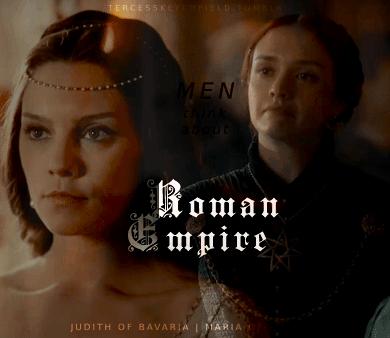
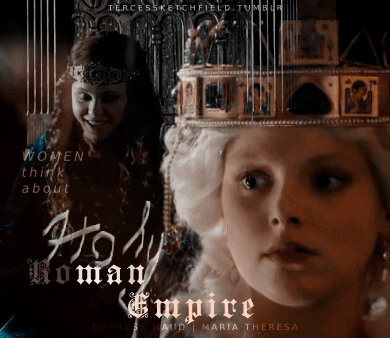
MEN THINK ABOUT ROMAN EMPIRE. WOMEN THINK ABOUT HOLY ROMAN EMPIRE
JUDITH OF BAVARIA (797-843) — Daughter of Count Welf I of Bavaria, Judith was a Carolingian Empress as the second wife of Louis I the Pious. Mother of Gisela and Charles the Bald, she foght for both her own influence at court and for the succession of her son over the claims of his elder half-brothers, the sons of Louis I from his first marriage. Charles became the Emperor in 875, after the death of Louis II, his nephew and a son of his half-brother Lothair / fancast: Annabel Scholey
MARIA OF AUSTRIA (1528-1603) — Daughter of Charles V, Holy Roman Emperor, and Isabella of Portugal. She served as Regent of Spain both jointly with her husband, Maximilian (before their accession to the imperial throne), and in person, for her father, and brother, Philip II. Her children include two Holy Roman Emperors, Rudolf II and Matthias, over whom she held great influence, and queens consorts of Spain, and France / fancast: Olivia Cooke
EMPRESS MAUD (1102-1167) — Daughter of Henry I of England and Matilda of Scotland. Her first marriage to the Holy Roman Emperor, Henry V, gave her the title under which she came down into history, and was a source of great pride to Maud. Rightful heiress of Henry I, she confronted her cousin, King Stephen, in the civil war, known as the Anarchy, fighting ferociously for her rights. She failed in this for herself but won for her son Henry, who became king and established the Plantagenet dynasty in England / cast: Alison Pill in The Pillars of the Earth (2010)
MARIA THERESA (1717-1780) — She succeded her father Charles VI as the ruler of Habsburg monarchy in 1740, and devoutedly defended it against its enemies in the War of Austrian Succession and the Seven Year's War. Wife of the Holy Roman Emperor, Francis I, she was a forceful personality and a competent ruler herself, reigning first in her own right, and later, jointly with her son Empreror Joseph II. Her children include two Holy Romam Emperors (Joseph II and Leopold II), queens consorts of Naples ans Sicily, and France / cast: Marie-Luise Stockinger in Maria Theresia (2017)
#historyedit#judith of bavaria#maria of austria#empress maud#empress matilda#maria theresa#maria theresia#perioddramaedit#history#women in history#perioddramasource#onlyperioddramas#tusereliza#userbennet#usermina#weloveperioddrama#cortegiania#perioddramagif#gifshistorical#my edit#*i have literally zero idea what is this lmao* but i really like it idk
114 notes
·
View notes
Text

🅾️🅱️2️⃣🏆, via weuro's ig, 29/2/24
#so proud of her#she's come so far#ona batlle#woso#espwnt#spain wnt#sefutbol fem#ig posts#uefa women's nations league#uwnl#spain v france
33 notes
·
View notes
Text
We brought you 279 Smoking Honeys since the series began on March 28, 2023. Some were Megaposts! Some had one POTD photo, a few had two or three. Some had video accompanyment!
2023 PHOTOS OF THE DAY
EXTRAVAGANZA/REVIEW
★ ★ ★ ★ ★+ | Five-Plus "Stars"
From vs120shound archives | ★★★★★ (13 total: L)
Dual-Media 15-Post, 112-Pack Megapost!

Photo of The Day Debut!
Natasha Anastasia of Smoking-Models.com (U.K.) from lostlighter23 on March 28, 2023, how we introduced the series with Post No. 1
HERE NOW ARE SOME OF THE
TOP PHOTOS FROM THE SERIES
Our 30 Best POTD Centerpiece Pictures
As selected by our team ⏤ 10 staff members, 3 administrators among vs120shound, lostlighter23, vs120shound-2 and lostlighter23-darkside
OUR TOP 30 COUNTDOWN OF POTD FAVORITES BEGINS . . .
Arranged in chronological sequence
Quinn from USA Smokers (Arizona, U.S.A.) on April 3

Morgan Lees from Smoking-Models (U.K.) on April 6

Kelly of Specialized Videos (Michigan, U.S.A.) on April 15

Ms. V. Elle Lyon on April 26

Sophia of SmokingModels (Florida, U.S.A.) on May 13

Stephanie of SmokingModels (Florida, U.S.A.) on May 20

Ellie of R.S. (Australia) on May 28

Monique Vegas of Switzerland on June 3 (addendum)

Sophie Hermann of Germany on June 5

Melanie from Lady Madonna on June 10

Laura of R.S. (Australia), but not our No. 1 all-time favorite SF model, on June 26

Natasha Marley of Smoking-Models (U.K.) on June 27

Edona Benovics of Eastern Europe on July 18

Katy of Specialized Videos (Michigan, U.S.A.) on July 26

Skittlez Cano, SF Entrepreneur, on August 3

Krystle (IG@puddin_forlife) of Massachusetts (U.S.A.) on Aug. 19

Janey of R.S. (Australia) on August 24

Sisters Elena and Julia of Spain (FutureSmoke, U.K.) on September 1

Maddy of SmokeVision and R.S. (Australia) on September 5

Annabelle of Nicotine Ladies (C4S) on September 6

Paula Kalinia of Toronto, Ontario, Canada on September 15

Valeria Pavelin of France on September 17

Sarah Arnold of Elegant Smoking (U.K.) on October 1

Marina of SmokinBabe.com on October 21

Kriss H., born in Ukraine, lives in Prague, Czech Rep., on Oct. 30

Casondra of Specialized Videos (Michigan, U.S.A.) on Nov. 9

Josee (Real Smoking Girl) of Ontario, Canada on November 10

Sian Hamshaw, formerly of Smoking-Models (U.K.), on Dec. 11

Bree of USA Smokers on December 17

Our Number One-Rated
Photo of The Day Post in 2023!
Josee, Real Smoking Girl, from November 10
And Our Runner-Up!
Laura, of R.S. (Australia), from September 5
#SF#Hot women who love smoking cigarettes#Smoking cigarettes#Smoking#279 Photo of The Day posts in 2023!
97 notes
·
View notes
Text
Oh! the Roast Beef of Old England: Roast Beef, English Nationalism, Effeminacy and Epilepsy (ft. Lord Hervey)
While today if asked what the national dish of England is some might say bangers and mash, Yorkshire pudding or chicken tikka masala in the 18th century the answer was roast beef.
It was roast beef that was the star of the patriotic 18th century song The Roast Beef of Old England. Originally written by Henry Fielding for his play The Grub-Steet Opera (1731) and then reused in Don Quixote in England (1734) the more popular version was written by Richard Leveridge who set it to a catchier tune and added five new stanzas:
When mighty roast Beef was the Englishman's Food,
It ennobled our Veins, and enriched our Blood;
Our Soldiers were brave, and our Courtiers were good.
Oh the roast Beef of old England, and old
English roast Beef.
But since we have learn'd from all-conquering France,
To eat their Ragouts, as well as to dance,
We are fed up with nothing, but vain Complaisance.
Oh the roast Beef, &c.
Our Fathers, of old, were robust, stout, and strong,
And kept open House, with good Chear all Day long,
Which made their plump Tenants rejoice in this Song.
Oh the roast Beef, &c.
But now we are dwindled, to what shall I name,
A sneaking poor Race, half begotten-and tame,
Who sully those Honours, that once shone in Fame.
Oh the roast Beef, &c.
When good Queen Elizabeth sat on the Throne,
E're Coffee, or Tea, and such Slip-Slops were known,
The World was in Terror, if e'er she but frown.
Oh the roast Beef, &c.
In those Days, if Fleets did presume on the Main,
They seldom, or never, return'd back again,
As witness, the vaunting Armada of Spain.
Oh the roast Beef, &c.
Oh then they had Stomachs to eat, and to fight,
And when Wrongs were a cooking, to do themselves right;
But now we're a-I could, but good Night.
Oh the roast Beef, &c.
Leveridge's version espouses the masculine qualities roast beef making Englishmen "brave", "robust," and "strong". Fielding's version from Don Quixote in England contrasts this English masculinity with the non-roast beef eating "effeminate Italy, France, and Spain". (Edgar V. Roberts, Henry Fielding and Richard Leveridge: Authorship of "The Roast Beef of Old England")
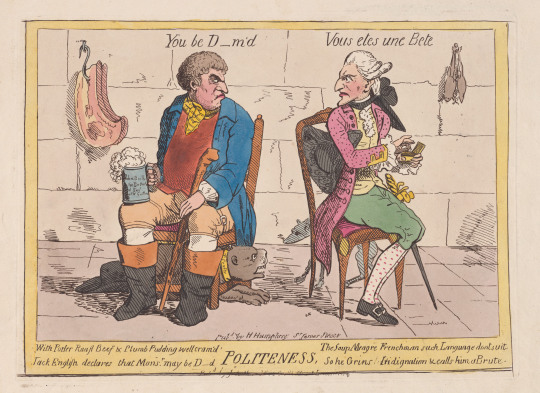
[Politeness, print, after 1780, published by Hannah Humphrey, after John Nixon (1779), via The Metropolitan Museum of Art.]
A common element of English nationalist propaganda was to contrast the masculine beef eating Englishman with the effeminate frogs legs eating Frenchman. The satirical print Politeness compares the masculine John Bull to a stereotypical effeminate Frenchman. John Bull is depicted as a plainly dressed man, holding a pint of beer, with a Bulldog at his feet and a cut of beef hanging behind him. The Frenchman in contrast is depicted as foppishly dressed, holding a snuff-box, with an Italian Greyhound at his feet and a bundle of Frogs hanging behind him. John Bull says "You be D_m'd". The Frenchman responds "Vous ete une Bete". The caption narrates:
With Porter Roast Beef & Plumb Pudding well cram'd, Jack English declares that Monsr may be D------d. The Soup Meagre Frenchman such Language dont suit, So he Grins Indignation & calls him a Brute.
In 18th century English print culture the butcher became somewhat of a stock figure representing English masculinity. There was a series of prints in which a masculine butcher is depicted assaulting a fop. Often with bystanders cheering him on. Some of these prints identified the fop as a Frenchman (such as The Frenchman in London by John Collet and The Frenchman at Market by Adam Smith) but others either don't identify nationality or indicate that the fop is English.

[The Beaux Disaster, print, c. 1747, via The Wellcome Collection.]
The Beaux Disaster depicts the aftermath of an altercation between a butcher and a fop. The butcher has hung the fop up by the back of his breeches on a hook next to cuts of meet. A crowd of passersby point and laugh at the fop, enjoying his misfortune. The caption narrates:
Ye smarts whose merit lies in dress, Take warning by a beaux distress. Whose pigmy size, & ill-tun'd rage Ventured with butchers to engage. But they unus'd affronts to brook Have hung poor Fribble on a hook, While foul disgrace! expos'd in air, The butchers shout and ladies stare. Satyr so strong, ye fops must strike you How can ye think ye fair will like you, Women of sense, in men despise The anticks, they in monkeys prize.
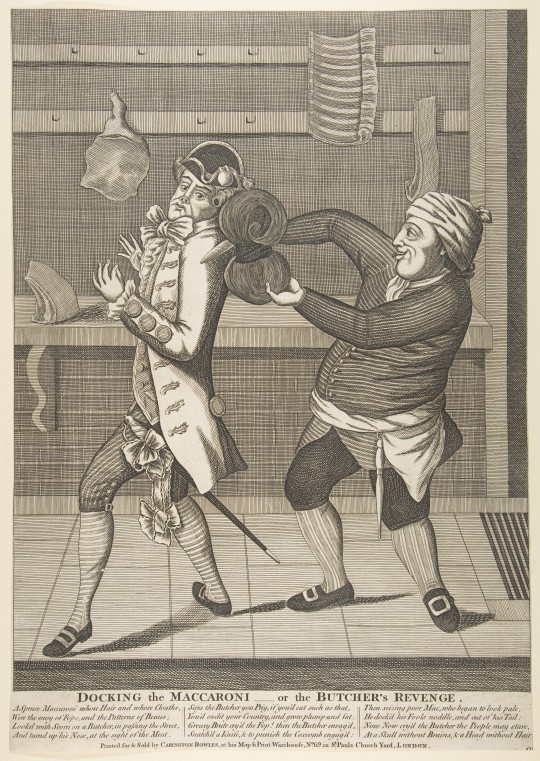
[Docking the Maccaroni–or the Butcher's Revenge, print, c. 1773, published by Carington Bowles, via The Metropolitan Museum of Art.]
Docking the Maccaroni–or the Butcher's Revenge depicts a butcher cutting off a macaroni's queue. Fashionable men in the late 1760s and 1770s would wear elaborate hairstyles sometimes with hair tied back into a 'club'. This hairstyle is a common element of macaroni satire (for a more flattering rendering of the style see George Simon Harcourt by Daniel Gardner). The caption narrates:
A Spruce Maccaroni whose Hair and whose Clothes, Were the envy of Fops, and the Patterns of Beaus; Looked with Scorn on a Butcher; in passing the Street, And turnd up his Nose, at the sight of the Meat. Says the Butcher you Pig, if you'd eat such as that, You'd credit your Country, and grow plump and fat. Greasy Brute cry's the Fop! then the Butcher enrag'd, Snatch'd a Knife, & to punish the Coxcomb engag'd: Then seizing poor Mac, who began to look pale, He docked his Fools noddle, and cut of his Tail: Now Now cry'd the Butcher the People may stare. At a Skull without Brains, & a Head without Hair.
The macaroni was often portrayed as a traitor to English culture not only for his love of french fashion but also his love of Italian pasta. The fabled 'macaroni club' was a reference to Almack's Assembly Rooms at 50 Pall Mall. (see Pretty Gentleman by Peter McNeil p52-55) The Macaroni and Theatrical Magazine (Oct 1772) explains that the origin of the word macaroni comes from:
a compound dish made of vermicelli and other pastes, which unknown in England until then, was imported by our Connoscenti in eating, as an improvement to their subscription at Almack's. In time, the subscribers to those dinners became to be distinguished by the title MACARONIES, and, as the meeting was composed of the younger and gayer part of our nobility and gentry, who, at the same time that they gave into the luxuries of eating, went equally into the extravagancies of dress; the word Macaroni then changed its meaning to that of a person who exceeded the ordinary bounds of fashion; and is now partly used as a term of reproach to all ranks of people, indifferently, who fell into this absurdity.
(Cited in Catalogue of Prints and Drawings in the British Museum edited by Frederic George Stephens and Edward Hawkins, vol.4, p.826)
Foppishly dressed men were blamed not only for the popularisation of pasta in England but also the growing disfavour for roast beef. A letter written to The Connoisseur in 1767 complains:
By Jove it is a shame, a burning shame, to see the honour of England, the glory of our nation, the greatest pillar of like, ROAST BEEF, utterly banished from our tables. This evil, like many others, has been growing upon us by degrees. It was begun by wickedly placing the Beef upon a side-table, and screening it by a parcel of queue-tail'd fellows in laced waistcoats.
(Volume 1, Edition 5)
With both his dress and diet the fop had betrayed English masculinity for French and Italian effeminacy.
Passed down by Lady Louisa Stuart* as an example of the "extreme to which Lord Hervey carried his effeminate nicety", when "asked at dinner whether he would have some beef, he answered, "Beef?— Oh, no!— Faugh! Don't you know I never eat beef, nor horse, nor any of those things?" Stuart was somewhat skeptical of this story wondering "Could any mortal have said this in earnest?"
*anonymously. Stuart wrote the introductory anecdotes included in the 1837 edition of The Letters and Works of Lady Mary Wortley Montagu.
While it's anyone's guess as to whether Hervey said these exact words it is true that he didn't eat beef. Not because he "courted" effeminacy with the "affected and almost finical nicety in his habits and tastes" as John Heneage Jesse suggests (in Memoirs of the Court of England from the Revolution in 1688 to the Death of George the Second) but for his health.
Lord Hailes explained:
Lord Hervey, having felt some attacks of the epilepsy, entered upon and persisted in a very strict regimen, and thus stopt the progress and prevented the effects of that dreadful disease. His daily food was a small quantity of asses milk and a flour biscuit : once a-week he indulged himself with eating an apple : he used emetics daily.
(The Opinions of Sarah Duchess-Dowager of Marlborough edited by Lord Hailes, p43)
Lord Hervey's doctor George Cheyne believed that "a total Milk, and Vegetable Diet, as absolutely necessary for the total Cure of the Epilepsy". (The English Malady, p254)
In An Account of My Own Constitution and Illness Hervey explains that he followed such a diet for three years on Cheyne's prescription eating "neither flesh, fish, nor eggs" but living "entirely upon herbs, roots, pulse, grains, fruits, legumes". (p969) However after three years he reintroduced white meet. He explains his diet in a letter to Cheyne, written on the 9th of December 1732:
To let you know that I continue one of your most pious votaries, and to tell you the method I am in. In the first place, I never take wine nor malt drink, or any liquid but water and milk-tea ; in the next, I eat no meat but the whitest, youngest, and tenderest, nine times in ten nothing but chicken, and never more than the quantity of a small one at a meal. I seldom eat any supper, but if any, nothing absolutely but bread and water ; two days in the week I eat no flesh ; my breakfast is dry biscuit not sweet, and green tea ; I have left off butter as bilious ; I eat no salt, nor any sauce but bread sauce. I take a Scotch pill once a week, and thirty grains of Indian root when my stomach is loaded, my head giddy, and my appetite gone. I have not bragged of the persecutions I suffer in this cause ; but the attacks made upon me by ignorance, impertinence, and gluttony are innumerable and incredible.
Intriguingly in An Account of My Own Constitution and Illness Hervey focuses more attention on colic than epilepsy, dismissing his seizures as rare, but admits he had "two this year". This leads to the impression that his diet was prescribed to treat colic rather than epilepsy and Cheyne did prescribe a milk and vegetable diet in cases of "extreme Nervous Cholicts". (p167) Perhaps it was prescribed to treat both. But why downplay epilepsy in an account of his own illness?
While some enlightenment doctors approached epilepsy with a more scientific approach, superstitions still remained. Some believed epilepsy was a form of lunacy that was controlled by the moon (the word lunatick coming from luna). In An Historical Essay on the State of Physick in the Old and New Testament Dr. Jonathan Harle claimed that "people in this distemper are most afflicted at full or change of the moon." (p124)
Many believed epilepsy was caused by possession and this belief was supported by the bible. Mark 9:17-27, Matthew 17:14-18 and Luke 9:37-43 tell the story of a man who brings his possessed son to Jesus who "rebuked the unclean spirit, and healed the child". The boy's symptoms resemble those of an epileptic seizure and these bible verses are cited by Dr. Jonathan Harle as "an exact description of one that is an epileptick (had the falling sickness) or lunatick". (p124) Harle claimed that was "a truth as plain as words can make it" that some people with epilepsy were "possess'd by the devil". (p22)
Epilepsy was also believed to be caused by sexual depravity. The popular anti-masturbation pamphlet Onania: or, the Heinous Sin of Self-Pollution claimed masturbation caused epilepsy (p23). Onanism: or, a treatise upon the disorders produced by masturbation, or, The dangerous effects of secret and excessive venery claimed that a 14-year-old boy "died of convulsions, and of a kind of epilepsy, the origin of which was solely masturbation". (p19)
With the stigma surrounding epilepsy its no wonder that Hervey kept his seizures secret only telling a select few. One of the people he trusted with this secret was his lover Stephen Fox. Hervey describes having a seizure while at court and keeping it hidden from the Royal Family in a letter to Fox written on the 7th of December 1731:
I have been so very much out of order since I writ last, that going into the Drawing Room before the King, I was taken with one of those disorders with the odious name, that you know happen'd to me once at Lincoln's Inn Fields play-house. I had just warning enough to catch hold of somebody (God knows who) in one side of the lane made for the King to pass through, and stopped till he was gone by. I recovered my senses enough immediately to say, when people came up to me asking what was the matter, that it was a cramp took me suddenly in my leg, and (that cramp excepted) that I was as well as ever I was in my life. I was far from it ; for I saw everything in a mist, was so giddy I could hardly walk, which I said was owing to my cramp not quite gone off. To avoid giving suspicion I stayed and talked with people about ten minutes, and then (the Duke of Grafton being there to light the King) came down to my lodgings, where * * * I am now far from well, but better, and prodigiously pleased, since I was to feel this disorder, that I contrived to do it à l'insu de tout le monde. Mr. Churchill was close by me when it happened, and takes it all for a cramp. The King, Queen, &c. inquired about my cramp this morning, and laughed at it ; I joined in the laugh, said how foolish an accident it was, and so it has passed off ; nobody but Lady Hervey (from whom it was impossible to conceal what followed) knows anything of it.
33 notes
·
View notes
Text
Ages of English Queens at First Marriage
I have only included women whose birth dates and dates of marriage are known within at least 1-2 years, therefore, this is not a comprehensive list. For this reason, women such as Philippa of Hainault and Anne Boleyn have been omitted.
This list is composed of Queens of England when it was a sovereign state, prior to the Acts of Union in 1707. Using the youngest possible age for each woman, the average age at first marriage was 17.
Eadgifu (Edgiva/Ediva) of Kent, third and final wife of Edward the Elder: age 17 when she married in 919 CE
Ælfthryth (Alfrida/Elfrida), second wife of Edgar the Peaceful: age 19/20 when she married in 964/965 CE
Emma of Normandy, second wife of Æthelred the Unready: age 18 when she married in 1002 CE
Ælfgifu of Northampton, first wife of Cnut the Great: age 23/24 when she married in 1013/1014 CE
Edith of Wessex, wife of Edward the Confessor: age 20 when she married in 1045 CE
Matilda of Flanders, wife of William the Conqueror: age 20/21 when she married in 1031/1032 CE
Matilda of Scotland, first wife of Henry I: age 20 when she married in 1100 CE
Adeliza of Louvain, second wife of Henry I: age 18 when she married in 1121 CE
Matilda of Boulogne, wife of Stephen: age 20 when she married in 1125 CE
Empress Matilda, wife of Henry V, HRE, and later Geoffrey V of Anjou: age 12 when she married Henry in 1114 CE
Eleanor of Aquitaine, first wife of Louis VII of France and later Henry II of England: age 15 when she married Louis in 1137 CE
Isabella of Gloucester, first wife of John Lackland: age 15/16 when she married John in 1189 CE
Isabella of Angoulême, second wife of John Lackland: between the ages of 12-14 when she married John in 1200 CE
Eleanor of Provence, wife of Henry III: age 13 when she married Henry in 1236 CE
Eleanor of Castile, first wife of Edward I: age 13 when she married Edward in 1254 CE
Margaret of France, second wife of Edward I: age 20 when she married Edward in 1299 CE
Isabella of France, wife of Edward II: age 13 when she married Edward in 1308 CE
Anne of Bohemia, first wife of Richard II: age 16 when she married Richard in 1382 CE
Isabella of Valois, second wife of Richard II: age 6 when she married Richard in 1396 CE
Joanna of Navarre, wife of John IV of Brittany, second wife of Henry IV: age 18 when she married John in 1386 CE
Catherine of Valois, wife of Henry V: age 19 when she married Henry in 1420 CE
Margaret of Anjou, wife of Henry VI: age 15 when she married Henry in 1445 CE
Elizabeth Woodville, wife of Sir John Grey and later Edward IV: age 15 when she married John in 1452 CE
Anne Neville, wife of Edward of Lancaster and later Richard III: age 14 when she married Edward in 1470 CE
Elizabeth of York, wife of Henry VII: age 20 when she married Henry in 1486 CE
Catherine of Aragon, wife of Arthur Tudor and later Henry VIII: age 15 when she married Arthur in 1501 CE
Jane Seymour, third wife of Henry VIII: age 24 when she married Henry in 1536 CE
Anne of Cleves, fourth wife of Henry VIII: age 25 when she married Henry in 1540 CE
Catherine Howard, fifth wife of Henry VIII: age 17 when she married Henry in 1540 CE
Jane Grey, wife of Guildford Dudley: age 16/17 when she married Guildford in 1553 CE
Mary I, wife of Philip II of Spain: age 38 when she married Philip in 1554 CE
Anne of Denmark, wife of James VI & I: age 15 when she married James in 1589 CE
Henrietta Maria of France, wife of Charles I: age 16 when she married Charles in 1625 CE
Catherine of Braganza, wife of Charles II: age 24 when she married Charles in 1662 CE
Anne Hyde, first wife of James II & VII: age 23 when she married James in 1660 CE
Mary of Modena, second wife of James II & VII: age 15 when she married James in 1673 CE
Mary II of England, wife of William III: age 15 when she married William in 1677 CE
102 notes
·
View notes
Text
Sequel to this one in which we wondered about the heirs that didn't survive
98 notes
·
View notes
Text
Blue Lock Chapter 245/NEL team rambling
foreword: I wrote this over Christmas, when suffering with a headcold. It's not that coherent, but I spent an amount of time on it? So have it as is... whatever it is.

God, they're doing Bachira Barcha so dirty.
If I'm interpreting this right, it sounds like Lavinho entered the game, but not Loki. Oof. Speaks volumes.
It took one of the most renowned footballers in the world to hold off Shidou and company so Bachira and Otoya could score.
It rankles how little development the Barcha boys are getting, compared to Manshine, Ubers or PXG. I know one team had to be the "first boss" of the NEL, but it's Bachira's team.
Bachira. Who's always shown the ability to thrive when the chips are down. Who's one of the most important characters, prior to the NEL.
Ugh. The story is entitled to focus on other characters, and overall I've enjoyed the outcome of this league. But you have to wonder how they can justify Barcha being this weak, even against a team as dominant as PXG.
Now, I did a fact-check to see if I'm just being salty (always a possibility). I looked at the teams by Blue Lock players, and specifically 1) who has a volume cover and 2) who is likely to get a volume cover between now and the manga ending.
My rationale? Volume covers are a proxy for talent/story significance, and appear to be an early bellwether for who might make it into the new U20 team lineup. Sendou fans rejoice
The results kinda support both the "me being salty" angle as well as the "Bachira is being deliberately ratio'd" one. Let me explain.

Germany are stacked next to the others, especially when they have both Kaiser and Ness as well. However: of the seven BL characters that have volume covers, four of these were revealed during the NEL arc. It makes sense, with Germany being the protagonist's team. But something to keep in mind, when we look at the others.

France has four characters that had volume covers before the NEL started. It's extremely likely Zantetsu will get one, and there's outside odds of Nanase also getting a cover. France has a potential NG11 or high-level player in Charles Chevalier. There's also Kento Cho, who had a not-insignificant role in the U20 v BL11 match. Worth noting.

I was surprised by how many high-profile characters Italy have, with five volume covers between them. This said, two characters (Niko and Sendou) only received theirs during the Ubers match arc, although I'd argue Niko would have received one earlier if it wasn't for Kaneshiro's commitment to the bit. Italy also has Don Lorenzo, possibly the most effective NG11 we've seen in action so far. IMO there's a slim chance Fukaku Gen will get a cover in future—the national team needs more than one goalie.

England have three volume cover stars: when you hear Manshine, all you can really picture is Nagi, Reo and Chigiri, right? In addition they have Wanima the elder and Niou, one of whom may sneak into the national team bench and nab a volume cover (my money's on Niou, solely because of that magnificent beard). Other than that, Manshine only has Agi, who's noted to have significant talent.

Lastly Spain, which has two volume covers to its credit and (in my view) low chances of any further ones. Maaaaybe Darai or Hayate, if we work off the current rankings (post round 3). But I can't see them beating Tokimitsu or Zantetsu for a Top 23 placement. They only have one notable Spanish player that has speaking lines (Ignacio Lara) but I wouldn't put him on, say, Agi's level.
To recap, the teams have this many significant characters as of the time of writing:
Germany: 7 + 2 (Kainess) + 2 (Igaguri, Kiyora) = 11.
Interestingly, a number that's give high status in this manga, and one that is often associated with Isagi.
France: 4 + 1 (Chevalier) + 2 (Zantetsu, Nanase) = 7
Italy: 5 + 1 (Lorenzo) + 1 (Fukaku) = 7
England: 3 + 1 (Agi) + 2?? (Niou, Wanima) = 6?? (closer to 5 really)
Spain: 2
If we retrospectively discount any character that didn't have a volume cover before the NEL arc kicked off, and reference only high-profile BL players:
Germany: 3
France: 4
Italy: 3
England: 3
Spain: 2
In conclusion: Spain has been outgunned since day one, and the story has failed to develop any of the Spanish players beside Bachira and Otoya... despite having a over a third of the national team front bench among its ranks.
I think Bachira and in particular, Otoya, have underperformed overall, considering their elevated position prior to the NEL. However, a repeated theme in the NEL is, you're only as good as the support or players around you.
Bachira and Otoya simply don't have the calibre of supporting midfielders, wingers or defensive players in Barcha that the other teams have. They don't have an NG11 player, or a defence capable of holding off a strong offensive opponent.
To get back to my original point: no wonder Lavinho had to sub on to give his two star players a chance to shine against PXG. It's indicative of the level of talent on the French front bench.
#i really don't know what my overall point was here#other than to vent about Bachira not getting a fair shake aha#i was very out of it over the xmas break in my defence#blue lock#bllk#bllk analysis#blue lock manga#blue lock manga spoilers#blue lock spoilers#bllk chp 245#bachira meguru#neo egoist league#boinin talks bllk
37 notes
·
View notes
Text
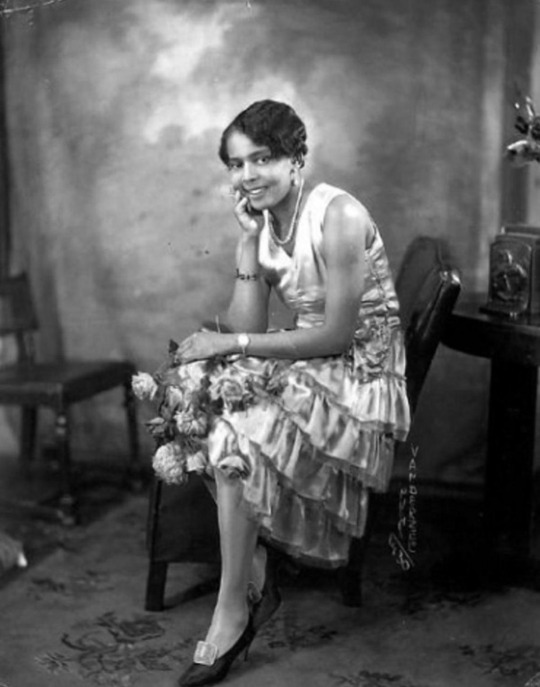

Esther Jones was known on stage by many names, including “Baby Esther,” “Little Esther,” “Farina’s Kid Sister,” and “Miniature Florence Mills,” is widely, although not universally, credited with being the inspiration for the Betty Boop cartoon character. Jones was born Esther Lee Jones in 1918 in Chicago, Illinois, to William Jones and Gertrude Jones.
In 1928, the Jones family moved to Harlem, New York. At seven, Jones was later known for adopting the popular singing style, scat, which emphasized the baby-style of “b” and “d” sounds and nonsense syllables such as Boo-Boo-Boo’ and ‘Doo-Doo-Doo.’ Consequently, she was a sought-after child performer in the city, and was a fixtured entertainer in the famous Cotton Club and the Everglades Nightclub in New York City during the latter years of the Harlem Renaissance. She added to her entertainment fame by become an extraordinary black-bottom dancer.
In 1929, Jones was taken to Spain, where she was called “La Pandilla.” Later she performed before Sweden’s Queen Sophie Marie Viktoria and King Gustaf V, in Stockholm. Despite her notoriety, she also experienced blatant racism when denied a glass of milk in an American-operated restaurant in Stockholm. The business, however, was forced to close after her treatment there became public knowledge.
Jones performed at the Moulin Rouge, Casino de Paris, and the Empire in Paris, France. There she was dubbed the “Miniature Josephine Baker.” While in Europe, she was paid an average $750 per week for her performances and by age 11, Jones was the highest-paid child on stage globally. After performing, Jones would go backstage to play with dolls. Whenever she performed, both parents were in attendance.
In 1930, Fleisher Studios in Hollywood introduced the cartoon character Betty Boop. Jones, however, received no royalties or performing credits despite the fact that a lawsuit would eventually expose Betty Boop’s true origins. The lawsuit ironically was brought by Helen Kane, a white performer, who sued Fleisher Studios for appropriating her “Betty Boop” character without her permission and without the payment of royalties. Over the course of the Fleisher Studios v. Kane trial, it was revealed that Kane had begun mimicking Jones’ scat act and even sang the same song, “I Want to Be Loved By You’ including the “Boop-Boop-a-Doop” reference. When Kane lost the lawsuit, other studios felt emboldened to promote the Betty Boop character but it recognized neither Kane or Jones as the source.
In 1934, Jones, now 16, performed in Philadelphia at a midnight benefit performance for the NAACP. That same year, she gave a stellar performance at the American Embassy in Rio de Janeiro, Brazil at the request of then Ambassador Jefferson Caffery. Brazil’s President Getúlio Dornelles Vargas, was in the audience and praised the performance and performer.
By 1940, however, the entertainment career of now 22-year-old Esther Jones, was over. She was no longer a child singing or dancing sensation. Esther Jones, now widely credited with influencing the iconic sex symbol Betty Boop, died in 1984 in New York City from liver and kidney complications. She was 66. Regardless of her role in the development of the Betty Boop cartoon character, Jones should be remembered as a child star with a brief but remarkable career in the entertainment industry.
•••
Esther Jones fue conocida en el escenario por varios nombres, incluyendo: “Baby Esther (Bebé Esther),” “Little Esther (Pequeña Esther),” “Farina’s Kid Sister (Hermanita de Farina),” y “Miniature Florence Mills (Florence Mills en miniatura). Generalmente, pero no universalmente, acreditada con ser la inspiración del personaje de caricatura, Betty Boop. Esther Lee Jones, nació en 1918 en Chicago, Illinois a sus padres William Jones y Gertrude Jones.
En 1928, la familia Jones se mudó a Harlem, Nueva York. A la edad de siete años, Jones fue reconocida por adoptar el famoso estilo de canto llamado ‘scat’ y resaltaba los sonidos de bebé que sonaban con ‘b’ y ‘d’, junto con sílabas que no tenían sentido como: Boo-Boo-Boo’ y ‘Doo-Doo-Doo.’ Consecuentemente, esto la convirtió en la artista infantil más buscada de la ciudad. Se convirtió en una presentadora fija en el famoso Cotton Club y el club nocturno Everglades en la ciudad de Nueva York, esto fue durante los últimos años del Renacimiento de Harlem. Le agregó más a su fama cuando se convirtió en una bailarina de black bottom (un paso de baile relacionado con el jazz tradicional).
En 1929, Esther fue llevada a España, dónde le llamaban “La Pandilla”. Poco después de eso, hizo una presentación en Stockholm frente a la Reina Sophie Marie Viktoria y el Rey Gustaf V de Suecia. A pesar de su notoriedad, también experimentó racismo muy evidente cuando se le negó un vaso con leche en un restaurante operado por americanos en Stockholm. Sin embargo, una vez que el trato que se le dio se hizo público, obligaron a que el negocio cerrara.
Jones se presentó en Moulin Rouge, Casino de Paris, and the Empire, ubicados en Paris, Francia. Es aquí donde le dieron el apodo de “Josephine Baker en miniatura”. Mientras que estuvo en Europa se le pagaban aproximadamente $750 por semana y con solo once años de edad, Jones era la artista infantil mejor pagada a nivel global. Después de sus presentaciones, ella se iba tras bastidores a jugar con muñecas. Sus padres siempre estaban presentes para las presentaciones.
En 1930, Fleisher Studios de Hollywood introdujo un nuevo personaje, Betty Boop. Y a pesar de que una demanda demostraría el verdadero origen de la caricatura, Jones nunca recibió crédito o derechos. Irónicamente, la demanda fue interpuesta por Helen Kane, una artista que había demandado a Fleisher Studios por apropiarse de su personaje “Betty Boop” sin su permiso y sin pagarle sus derechos. Durante el juicio Fleisher Studios v. Kane, se reveló que Kane había comenzado a imitar el acto de scat de Jones y que incluso cantaba las mismas canciones como ‘I Want to Be Loved By You’ incluyendo la referencia: “Boop-Boop-a-Doop”. Cuando Kane perdió la demanda, otros estudios se animaron a promover al personaje Betty Boop, sin reconocer a Kane o Jones como la fuente.
En 1934, Jones, ahora con dieciséis años de edad, hizo una presentación en Philadelphia para una noche de beneficencia de la Asociación Nacional para el Progreso de la Gente de Color (NAACP). Ese mismo año, a petición del embajador Jefferson Caffery, hizo una presentación estelar en la embajada americana ubicada en Rio de Janeiro, Brazil. El presidente Getúlio Dornelles Vargas se encontraba en la audiencia, elogió la presentación y también a la presentadora.
Para 1940, con veintidós años de edad, la carrera de Esther Jones en la industria del entretenimiento, ya se había acabado. Ya no era una sensación infantil que bailaba y cantaba. Esther Jones, ahora extensamente acreditada con ser la influencia del símbolo sexual, Betty Boop, murió en 1984 en la ciudad de Nueva York, por complicaciones renales y hepaticas. Tenía 66 años. Independiente de su rol en el desarrollo del personaje, Betty Boop; Esther Jones debería de ser recordada como una estrella infantil que tuve una carrera corta pero extraordinaria.
#culture#knowyourhistory#like#follow#newpost#historyfacts#blackgirlmagic#black women#black women matter#blacklivesmatter#blacklivesalwaysmatter#english#spanish#blackhistory#history#share#read#blackpeoplematter#blackhistorymonth#black lives matter#blackgirlsread#blackbloggers#blackownedandoperated#black girl icons#black music#b#black history is american history#blm#betty boop#knowledgeisfree
198 notes
·
View notes
Text
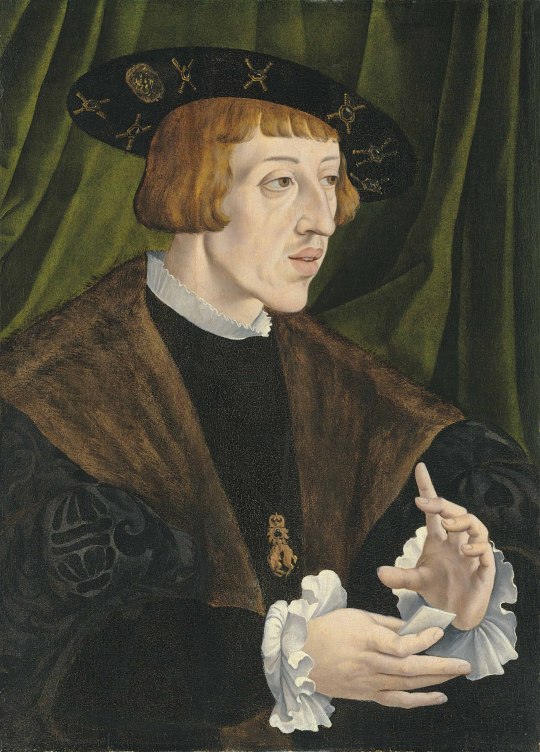
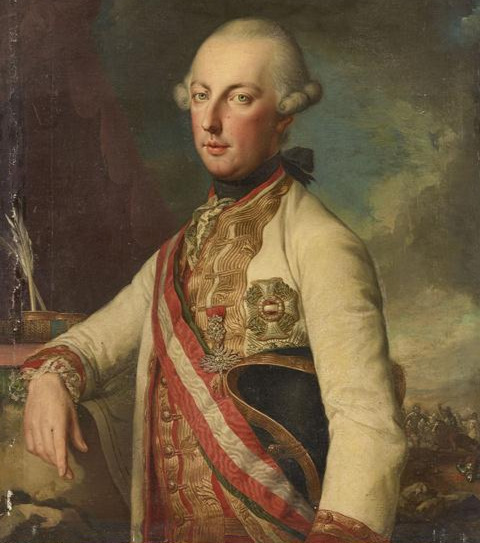
Ferdinand I, Holy Roman Emperor, reigned 1556-1564
Charles V's right hand arm man
From @master-of-the-opera-house:
Good taste in armour: Madonna with child chestplate?? Fox helmet?? SLAY
Mostly uncredited in his role as Charles V's Silly Rabbit in the HRE. Helped his brother take the reigns waaaay before he officially became Emperor, first in 1522 ((lad was only 19!!)) and then in 1531. That's like over 20 years of Lack Of Credit.
Managed to band-aid the reformation situation: ultimately succeeded at reforms ((better than Joseph II did seeing he's up against him))
Ultimate Power didn't make him Act Out like Charles V or.... Joseph II.
Went from being loved in Spain to hated in central Europe to Respected again, how many people can win that back??
Slutty twink proportions like what do you need that small of a waist for for other men to grab it?? ((see armour))
Pretty hands
the HOT SIBLING according to contemporaries including Maximilian I yum
Had 13 kids which is an insane feat if you're a Habsburg who isn't Maria Theresia. Maybe the above had to do with it?
Looked like drag queen/the WINNER of Drag Race France Paloma if you're delusional enough
from
@minetteskvareninova: he was completely faithful to his wife and a veritable wife guy? As a 16th century monarch??? The scandal. Are you even a Ferdinand I. girlie if you don't mention Anna Jagiellon?! Ferdinand himself would be PISSED.
Joseph II, Holy Roman Emperor, reigned 1765-1790
Reformer, Patron of the Arts, Archduke of Mommy issues
From anon: "I mean... Does this dude even NEED propaganda?! If this guy doesn't make you root for an absolute monarch, then noone will. Like with the caveat that enlightened absolutism is still absolutism and thus still not a GOOD way to run a state - well, Joseph II. was truly the most enlightened of absolutists. Just the fact that he abolished serfdom and instituted religious tolerance in Habsburg domains is enough to make him stand far above all of his predecessors and successors. Like, all of the other contestants can go home. None of them could ever top that (Franz Joseph I. had several opportunities, but wasn't keen on taking them). Even his other reforms were at worst misguided, but driven by genuine desire to better his country. Plus, you have to feel bad for him - the poor guy busted his ass for the country, just to have to take back a lot of his reforms simply because they were too ahead of their time, both of his marriages were unhappy (partially his own fault, but only partially) and, lest we forget, both of his kids died young. Voting for him is the least you can do for my poor baby!"
anti-Joseph II, from anon: Joseph II anti propaganda cheated like hell and treated his nephew Franz I (II) really mean by denying him company and food sometimes and also insulting him all the time. only good thing about him was that he was in Amadeus (1984) which was a banger film
from the tags:


36 notes
·
View notes